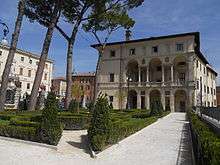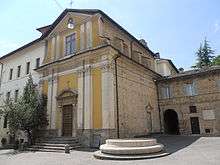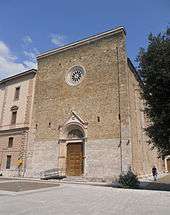Rieti
| Rieti | |||
|---|---|---|---|
| Comune | |||
| Comune di Rieti | |||
|
Bell tower of St. Mary Cathedral | |||
| |||
 Rieti Location of Rieti in Italy | |||
| Coordinates: 42°24′N 12°52′E / 42.400°N 12.867°ECoordinates: 42°24′N 12°52′E / 42.400°N 12.867°E | |||
| Country | Italy | ||
| Region | Lazio | ||
| Province | Rieti (RI) | ||
| Frazioni | Case San Benedetto, Casette, Castelfranco, Cerchiara, Chiesa Nuova, Cupaello, Lisciano, Lugnano, Maglianello, Moggio, Piane di Poggio Fidoni, Piani di Sant'Elia, Piè di Moggio, Poggio Fidoni, Poggio Perugino, San Giovanni Reatino, Sant'Elia, Vaiano, Vazia | ||
| Government | |||
| • Mayor | Simone Petrangeli (SEL) | ||
| Area | |||
| • Total | 206.52 km2 (79.74 sq mi) | ||
| Elevation | 405 m (1,329 ft) | ||
| Population (30 April 2008) | |||
| • Total | 47,745 | ||
| • Density | 230/km2 (600/sq mi) | ||
| Demonym(s) | Reatini | ||
| Time zone | CET (UTC+1) | ||
| • Summer (DST) | CEST (UTC+2) | ||
| Postal code | 02100 | ||
| Dialing code | 0746 | ||
| Patron saint | St. Barbara | ||
| Saint day | December 4 | ||
| Website | Official website | ||
Rieti (Italian: [ˈrjɛːti]; Latin: Reate) is a city and comune in Lazio, central Italy, with a population of c. 47,700. It is the capital of province of Rieti.
The town centre rests on a small hilltop, commanding a wide plain at the southern edge of an ancient lake. The area is now the fertile basin of the Velino River. Only the small Ripasottile and Lungo lakes remain of the original large one.
History
Ancient era

Reate was originally a major site of the Sabine nation. After the Roman conquest, carried out by Manius Curius Dentatus in the late 3rd century BC, the village became a strategic point in the early Italian road network, dominating the "salt" track (known as Via Salaria) that linked Rome to the Adriatic Sea through the Apennines.
Curius Dentatus drained a large portion of the lake by making the Velino a distributary of the Nera river. The wide area once occupied by the lake turned into a fertile plain. Following Roman customs, the land was split into characteristic square allotments. The town itself underwent significant development, being re-organised according to typical Roman urbanistic standards (e.g., two orthogonal roads make up the settlement's backbone), and was fortified with strong walls. A stone bridge was laid across the Velino river, and a large viaduct was built to bring goods from the Salaria road directly to Rieti's southern door.
Roman Reate receives a number of mentions in Latin literature, thanks to its flourishing soil, its valued assets, and some peculiarities of the surroundings (such as wandering islands and hollow-subsurfaced fields). Cicero, for instance, describes the tensions between Reate and Interamna (Terni) following the lake drainage, and refers to the country houses (villae) that his friend Q. Axius owned in the plain.
Middle Ages
After the fall of the Western Roman Empire Rieti suffered destruction by Barbarians, but never ceased to be an important gastaldate during the Lombard domination, as part of the Duchy of Spoleto. Under the Franks, it was county capital. It was sacked by the Saracens in the 9th and 10th century and by the Norman king Roger II of Sicily in 1149.
The city was rebuilt with the help of the Roman comune, and from 1198 was also a free commune, of Guelph orientation, with a podestà of its own.
As a favourite Papal seat, Rieti was the place of important historical events: Constance of Hauteville married here by proxy Emperor Henry VI (1185). Charles I of Anjou was crowned King of Apulia, Sicily and Jerusalem by Pope Nicholas I in 1289. Pope Gregory IX celebrated canonized St. Dominic in Rieti (1234).
Late Middle Ages and modern era
After the Papal seat had been moved to Avignon, Rieti was conquered by the King of Naples, while inner struggles between Guelphs and Ghibellines broke out. In 1354 it was won back by Cardinal Albornoz, and it later became a feudal seignory of the Alfani family within the Papal States. More of the surrounding plain was drained in the following century, but this led to confrontation with the neighboring Terni.
Rieti was province capital of the Papal States from 1816 to 1860. After the unification of Italy, it was initially part of Umbria, being annexed to Lazio in 1923. It became the provincial capital on January 2, 1927.
Climate
| Climate data for Rieti | |||||||||||||
|---|---|---|---|---|---|---|---|---|---|---|---|---|---|
| Month | Jan | Feb | Mar | Apr | May | Jun | Jul | Aug | Sep | Oct | Nov | Dec | Year |
| Average high °C (°F) | 8 (46) |
10 (50) |
13 (55) |
17 (63) |
22 (72) |
25 (77) |
29 (84) |
29 (84) |
25 (77) |
20 (68) |
14 (57) |
9 (48) |
18.4 (65.1) |
| Average low °C (°F) | 1 (34) |
0 (32) |
2 (36) |
5 (41) |
8 (46) |
11 (52) |
13 (55) |
13 (55) |
11 (52) |
7 (45) |
4 (39) |
1 (34) |
6.3 (43.4) |
| Average precipitation mm (inches) | 111 (4.37) |
110 (4.33) |
95 (3.74) |
93 (3.66) |
75 (2.95) |
70 (2.76) |
35 (1.38) |
55 (2.17) |
87 (3.43) |
106 (4.17) |
171 (6.73) |
146 (5.75) |
1,154 (45.44) |
| Source: [1] | |||||||||||||
Main sights




.jpg)

The downtown of the ancient Sabine and Roman city was crowded with buildings, including baths (thermae). Only scarce remains were found during excavations in 19th and 20th century: the foundations of a large temple, the stone floor of the main square (forum), walls from private houses, concrete vaults, statues and pottery items. The most striking remains are the stone bridge across the Velino river and the viaduct.
Piazza San Rufo is traditionally considered to be the exact centre of Italy (Latin Umbilicus Italiae).
Other sights include:
- Rieti Cathedral, started in 1109 over a pre-existing basilica, was consecrated in 1225 and almost entirely rebuilt in 1639. It has a stunning Romanesque bell tower from 1252. The entrance portico leads to a noteworthy portal from the 13th century. The interior, on Latin cross plan with one nave and two aisles, has mainly Baroque decorations. Notable is a statue of St. Barbara by Giannantonio Mari (1657), probably designed by Bernini. Other art pieces include a fresco by Antoniazzo Romano and canvases from 16th and 17th centuries. The crypt corresponds to the most ancient part of the church, consecrated in 1157. The Baptistery has an elegant baptismal font from the 15th century.
- Palazzo Vescovile ("Bishops Palace" or "Papal Palace"), whose construction was begun in 1283. Noteworthy are the loggia and eight Renaissance-style windows from 1532. The lower floor is occupied by the so-called "Volte del Vescovado", a great portico with two naves of Gothic arcades. The Grand Hall houses the Diocese Gallery.
- Palazzo Comunale ("Town Hall", 13th century, rebuilt in the 18th century), facing Piazza Vittorio Emanuele II, a square corresponding to the ancient Roman forum. The Palace houses the Town Museum which hosts works by Antoniazzo Romano, Antonio Canova, Bertel Thorwaldsen.
- Palazzo del Governo, with a noble loggia from 1596.
- the Bishop's Arch, a bridge built by Boniface VIII.
- San Pietro Martire - church of St. Peter Martyr (13th century), with luxurious golden Baroque decorations. It has a Presentation of Christ to the Temple by Giovanni Battista Gaulli.
- Palazzo Vicentini, attributed to Giuliano da Sangallo the Younger.
- the Walls, dating from the first half of the 13th century, with characteristical rounded and square towers.
- the Gothic church of Sant'Agostino (13th century, restored in the 18th century). The portal has a fresco of Madonna with Child and St. Augustin and St. Nicholas (1354), of Senese school.
- Santa Maria in Vescovio, a church built in the 8th century and subsequently modified to the current 12th century Romanesque appearance. The interior has a single nave and frescoes from the late 13th-early 14th centuries, depicting the Last Judgement and scenes from the Old and New Testament.
- the church of St. Francis (begun in 1245, radically restored in 1636). The interior has a single nave. The original frescoes from the 14th-15th centuries depicting scenes from the life of St. Francis and the Virgin and Child[2] are now in the Diocese Museum and in the Palazzo Vescovile.
- the late Renaissance Palazzo Vecchiarelli, designed by Carlo Maderno.
Also interesting are the sights in the Lake Lungo and Ripasottile Natural Preserve, and the Mount Terminillo.
Notable people
- Marcus Terentius Varro (116–27 BC), Roman scholar and writer.
- Antonio Gherardi (1638–1702) Italian painter, architect, and sculptor (stuccoist).
- Giuseppe Ottavio Pitoni (1657–1743), composer.
- Giuseppe Ferrari (1840–1905), painter.
- Arduino Angelucci (1901–1981) Italian painter, architect, sculptor and mosaicist.
- Elio Augusto Di Carlo (1918–1998) Italian ornithologist, historian and physician.
- Renzo De Felice (1929–1996), historian of Fascism.
Twin cities
Transportation
Rieti can be reached from the A1 (Rome-Florence) motorway from the Orte gate, and then through the SS 79. The city is also connected to Rome by the SS 4 Via Salaria.
Rieti has a station on the Terni–Sulmona railway.
Sport
- The biggest football club in Rieti is Serie D team, FC Rieti who play at the Stadio Centro d'Italia – Manlio Scopigno.
- American basketball player Joe Bryant played in Rieti from 1984 to 1986, and then another 5 years in Italy; his son Kobe Bryant, now also an NBA player, attended school in Rieti and as a result speaks fluent Italian to this day.
- Italian athlete Andrew Howe grew up in Rieti.
- Jamaican sprinter Asafa Powell ran the then world record time of 9.74 s in the 100 meters at the Rieti Athletics meeting on September 9, 2007. The record stood until Usain Bolt broke it on 31 May 2008.
- Kenyan runner David Rudisha ran a world record time of 1:41.01 in the 800 meters at the Rieti Athletics meeting on August 29, 2010. The record stood until Rudisha beat his own mark at the 2012 Summer Olympics in London, running a 1:40:91 on August 9, 2012.
- The European Athletics Junior Championships were held at the Stadio Raul Guidobaldi in Rieti from 18–21 July 2013.
References
- ↑ "Climate averages: Rieti, Italy". EuroWeather. Retrieved 5 December 2008.
- ↑ Péter Bokody, "Secularization and Realistic Turn in Italy: Antonio Fissiraga's Funerary Monument in Lodi," IKON: Journal of Iconographic Studies 5 (2012): 351-363. https://www.academia.edu/1796258/Secularization_and_Realistic_Turn_in_Italy_Antonio_Fissiragas_Funerary_Monument_in_Lodi
External links
| Wikisource has the text of the 1905 New International Encyclopedia article Rieti. |
|


